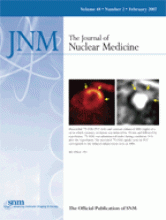TO THE EDITOR: In a recent study by Neti and Howell (1), the distribution of cellular uptake of radioactivity (210Po-citrate) within a cell population was studied. They found that the distribution was log normal. Furthermore, they calculated how this distribution affects the radiopharmaceutical's ability to kill cells, and they found a cell kill that is smaller than that with a homogeneous uptake. The background for doing this work, as presented by Neti and Howell, was that numerous articles that dealt with the calculation methods had been published, but none of these took into account this heterogeneity in cellular uptake.
However, we must call attention to an article published in 2001 by Kvinnsland et al. (2) in which these issues were addressed. The focus of that study was the radiobiologic implications of this sort of heterogeneity as well as the variations in cell radius and nuclear radius. Also, in this study, it was found that the distribution was log normal, and the surviving fractions of cells were estimated to be higher than the fractions found with assumptions about uniform uptake.
In the article by Neti and Howell (1), the main focus is on the method for measuring the distribution, whereas in the article by Kvinnsland et al. (2), more attention is given to the calculations. Neti and Howell exposed cells to different concentrations of 210Po-citrate, washed the cells, and seeded them in dishes or on plates covered with photographic emulsion. The number of α-particle tracks originating from the individual cells was then counted, and the distribution of activity in the cells was then estimated. Subsequently, the effects on theoretic survival curves from this heterogeneity in cell-bound activity were calculated.
In the work by Kvinnsland et al. (2), cells were labeled with phycoerythrin-conjugated antibodies, and the distribution of immunofluorescence intensities, reflecting the surface antigen expression, was measured in a flow cytometer. This distribution was later assumed to be equal to the distribution of activity on the cell surface of cells exposed to radiolabeled antibodies. Using this assumption, the survival curves were estimated for antibodies labeled with an imaginary isotope emitting α-particles with 7-MeV energy. Furthermore, errors in estimates of radiosensitivity based on an assumption about linear survival curves were calculated for varying proportions of cell-bound activity and activity in the medium surrounding the cells.
There are obvious advantages and disadvantages of both methods. The disadvantage of flow cytometry is, of course, that all chemical compounds cannot be labeled with a fluorophore, and in such cases the method with radiolabeling must be used. For example, it does not make sense to label citrate with phycoerythrin. Therefore, the study by Neti and Howell (1) is important.
However, when flow cytometry is possible, the antigen expression of a vast number of cells can be measured in a short time and it is possible to expose the cells to high concentrations of antigens. This is in contrast to the method with photoemulsion, which is very laborious, and, because the number of tracks must be limited, the distribution has to be measured part by part by varying the concentrations of radiochemicals and exposure times. This gives rise to another fundamental mathematic problem. If the number of tracks per cell is low, the counted number of tracks is a Poisson variable. In other words, the distribution observed is not the distribution of radioactivity in the cells but, rather, the distribution convolved with the Poisson distribution. In the article by Neti and Howell (1), the fact that the variable is poissonian is pointed out but, as we have understood their mathematic methods, this is not handled; furthermore, the track counts for short exposure times are simply adjusted to the longer exposure times by multiplication by a factor taking into account the longer decay times, ignoring the fact that the Poisson distribution is changing with increasing expected values.
Footnotes
-
COPYRIGHT © 2007 by the Society of Nuclear Medicine, Inc.







